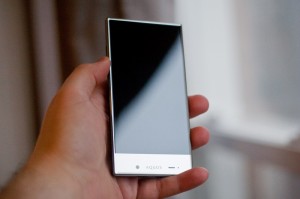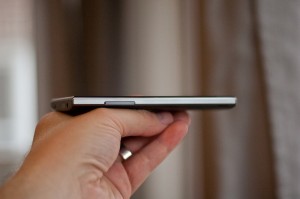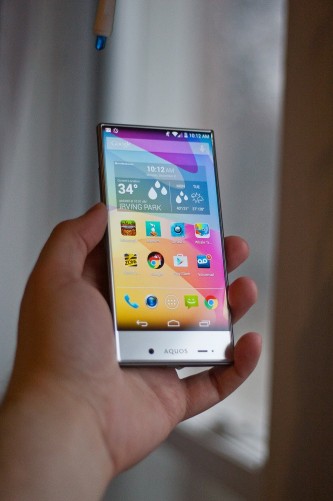In the smartphone world, Sharp is known primarily as a supplier of displays for other companies’ devices, not as a handset manufacturer itself. As such, the Aquos Crystal is an unexpected foray for the storied Japanese electronics company, and it’s quite the head-turner as well.
It’s obvious at a glance: the Aquos Crystal features almost no visible bezel around the five-inch display—a neat trick made even more surprising by the phone’s budget pricing. Has there been a more distinctive handset on the low end of the price scale in recent memory? In a market saturated with innocuously designed, unremarkable-looking Android devices, it’s a breath of fresh air.
But there are major drawbacks, and not even the usual ones you’d expect from the price—the Sprint model we reviewed sells for $240 outright—like unremarkable performance and some lower-quality components. In fact, it’s the unique form that causes many frustrations, reminding us that a cool-looking phone probably isn’t worth the fuss if its best quality is merely looking cool.
Build and Design
Need we even say it? There’s just nothing quite like the Sharp Aquos Crystal, and that’s true from the entry-level to the flagship ends of the modern smartphone scale. Sharp clearly intended to make a big splash with its first U.S. phone in a few years, and to that aim, we say: mission accomplished.
But expectedly, putting an edge-to-edge five-inch display on a phone with extremely minimal bezel on three sides results in a very untraditional design. Namely, there’s a big block of space on the bottom of the phone’s face with a couple things you usually find up top—like the 1.2-megapixel front camera and the notification light. We’ll touch on the camera in a bit, but as you might expect, everyday use requires some adjustments if you’re moving over from something with a more familiar design.
The Aquos Crystal keeps a moderate profile for a five-inch device, coming in at 5.17 x 2.64 x 0.4 in., with a weight of 4.97 oz. It’s not ultra-thin, certainly, but the unique build doesn’t add an uncomfortable level of bulk either. And while it might look like a premium device at a glance, it doesn’t really feel like it: The grey plastic sides and stiff backing don’t seem particularly labored over or refined.
You’ll find the power button and 3.5mm audio jack on the top, the microUSB port on the bottom, and a volume rocker on the upper left that barely juts out from the surface. Beneath the removable back cover is access to the SIM card and a slot for up to a 128 GB microSD card, which you’ll likely want since there’s only 8 GB of internal storage included by default.
Display
It’s the Aquos Crystal’s most obvious perk, yet it proves to be one of its biggest downfalls: the design of the display. To be fair, the 720p LCD screen itself is, well, quite sharp. It’s super bright, with solid contrast and coloring, and at 294 ppi, it’s crisp enough to get the job done. And truly, the phone’s overall build highlights the display, making it seem almost like you’re holding a screen and nothing else.
But that initial sensation gives away to some serious annoyances, the biggest of which has to be Sharp’s decision to angle the edges of the screen with a chamfer surrounding the glass on all sides. It’s similar to what Motorola did with the Moto 360 smartwatch.
What might have been a move to make the Aquos Crystal more visually distinctive instead ends up distorting the screen quality from nearly every angle. No matter how you look at it, some small portion of the display will have an odd, distracting effect over it. Furthermore, the angled glass looks extra thick and creates a distorted sense of distance between your finger and the actual component housed beneath. And because the screen comprises so much of the phone’s face, it appears to collect dust and fingerprints more easily than most others, only amplifying that effect.
And much as we might ooh and ahh over the lack of bezel, the trade-off becomes clear once you start using the phone: You really need something to separate your fingers from the sides of the multitouch screen. We experienced multiple instances of the device reading a touch from the absolute edge of the screen simply by virtue of how we held it—a particular irritation for games with a pause icon in the upper corner. Perhaps long term, extended use will help you learn to avoid such issues via different hand positions, but the inability to hold this smartphone like a regular smartphone is one of the stranger initial quirks.
The post Sharp Aquos Crystal Review: Eye-Catching, But That’s It appeared first on Brighthand.com.


